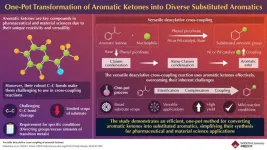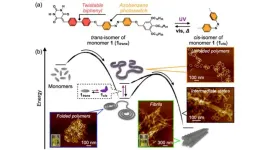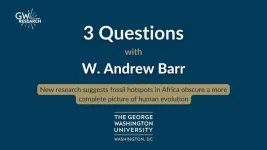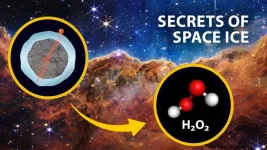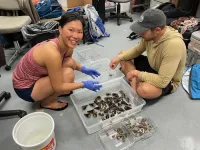(Press-News.org) A study of children’s conversations with their caretakers sheds light on the timeline of the emergence of moral foundation words in the first six years of life in English-speaking children. Moral Foundations theory posits that morality is largely intuitive and underlaid by modular foundations. The original set of five foundations proposed by researchers includes Care/Harm, Fairness/Cheating, Authority/Subversion, Loyalty/Betrayal, and Purity/Degradation. Aida Ramezani and colleagues systematically identified words related to these moral foundations in 44 text corpora from the CHILDES dataset, a large database of transcripts of children’s speech used by researchers, seeking to establish a timeline for the emergence of these ideas in children’s lexicons. Words that appear in contexts relevant to moral foundations are extracted from dyadic conversations between children and caretakers. The authors find that children use words related to Care/Harm at much higher rates than all the other foundations. Care/Harm and Fairness/Cheating, which focus on benefits to the individual and are thus known as “individualizing foundations,” emerge earlier than Authority/Subversion, Loyalty/Betrayal, and Purity/Degradation, which focus on benefits to a wider group and are thus known as “binding foundations.” The Care/Harm foundation is present in the speech of one-year-olds, in utterances such as “help Carrie wash dish.” Caretakers speak more often about Purity/Degradation than children do. According to the authors, caretakers tend to talk about fairness, while children tend to talk about cheating, in utterances such as the childhood classic: “That’s not fair!”
END
The emergence of moral foundations in children’s speech
2024-08-20
ELSE PRESS RELEASES FROM THIS DATE:
Correcting misperceptions of opposing party won’t reduce polarization
2024-08-20
Political animus between Republicans and Democrats in the United States is alarmingly high, raising fears of undemocratic or even violent actions. An often-touted intervention to prevent political polarization is to identify and correct misperceptions about people’s partisan opponents. Sean Westwood and colleagues sought to empirically test the effectiveness of this strategy. The authors surveyed 9,810 American partisans online from fall 2022 to fall 2023, finding that their opinions of whether ...
Scientists discover new code governing gene activity
2024-08-20
A newly discovered code within DNA – coined “spatial grammar” – holds a key to understanding how gene activity is encoded in the human genome.
This breakthrough finding, identified by researchers at Washington State University and the University of California, San Diego and published in Nature, revealed a long-postulated hidden spatial grammar embedded in DNA. The research could reshape scientists’ understanding of gene regulation and how genetic variations may influence gene expression in development or disease.
Transcription factors, the proteins that control which genes in one’s genome are turned on or off, ...
The invasion of Ukraine and European attitudes
2024-08-20
An ongoing survey captures how the Russian invasion of Ukraine affected attitudes in European countries not directly involved in the conflict. Margaryta Klymak and Tim Vlandas examine how the Russian invasion of Ukraine affected economic and political attitudes in eight European countries. The authors took advantage of the timing of the European Social Survey (ESS), which happened to be administered both just before and just after the Russian invasion of Ukraine in February 2022 in eight countries: Switzerland, Greece, Italy, Montenegro, Macedonia, Netherlands, Norway, and Portugal. Overall, the invasion increased support ...
A new reaction to enhance aromatic ketone use in chemical synthesis
2024-08-20
Aromatic ketones have long been valuable intermediates in chemical synthesis, particularly in cross-coupling reactions where different chemical entities are combined to form new compounds. For instance, a process called deacylative cross-coupling removes the acyl group from the aromatic ketone, allowing it to bond with other chemicals and produce a wide variety of useful compounds. These reactions are crucial for producing a wide array of aromatic compounds used in various industries like agrochemicals.
However, the utility of aromatic ketones has been limited due to the difficulty in breaking their strong carbon-carbon bonds. These robust bonds are challenging to cleave, ...
Investigating the interplay of folding and aggregation in supramolecular polymer systems
2024-08-20
In polymers, the competition between the folding and aggregation of chains, both at an individual level and between chains, can determine the mechanical, thermal, and conductive properties of such materials. Understanding the interplay of folding and aggregation presents a significant opportunity for the development and discovery of polymeric materials with tailored properties and functionalities.
This also holds true for non-covalent counterparts of conventional covalent polymers, i.e., supramolecular polymers (SPs). SPs are expected to have practical applications as novel stimuli-responsive ...
Adaptive 3D printing system to pick and place bugs and other organisms
2024-08-20
MINNEAPOLIS / ST. PAUL (08/20/2024) — A first-of-its-kind adaptive 3D printing system developed by University of Minnesota Twin Cities researchers can identify the positions of randomly distributed organisms and safely move them to specific locations for assembly. This autonomous technology will save researchers time and money in bioimaging, cybernetics, cryopreservation, and devices that integrate living organisms.
The research is published in Advanced Science, a peer-reviewed scientific journal. The researchers ...
Fossil hotspots in Africa obscure a more complete picture of human evolution
2024-08-20
WASHINGTON (August 20, 2024) – Much of the early human fossil record originates from just a few places in Africa, where favorable geological conditions have preserved a trove of fossils used by scientists to reconstruct the story of human evolution. One of these fossil hotspots is the eastern branch of the East African Rift System, home to important fossil sites such as Oldupai Gorge in Tanzania. Yet, the eastern branch of the rift system only accounts for 1% of the surface area of Africa—a fact that makes it possible to estimate how much information scientists who rely on such small samples are missing.
In ...
Extraterrestrial chemistry with earthbound possibilities
2024-08-20
DENVER, Aug. 20, 2024 — Who are we? Why are we here? As the Crosby, Stills, Nash & Young song suggests, we are stardust, the result of chemistry occurring throughout vast clouds of interstellar gas and dust. To better understand how that chemistry could create prebiotic molecules — the seeds of life on Earth and possibly elsewhere — researchers investigated the role of low-energy electrons created as cosmic radiation traverses through ice particles. Their findings may also inform medical and environmental applications on our home planet.
Undergraduate student Kennedy Barnes will present the team’s results at the fall meeting of the American ...
Deadly sea snail toxin could be key to making better medicines
2024-08-20
Scientists are finding clues for how to treat diabetes and hormone disorders in an unexpected place: a toxin from one of the most venomous animals on the planet.
A multinational research team led by University of Utah scientists has identified a component within the venom of a deadly marine cone snail, the geography cone, that mimics a human hormone called somatostatin, which regulates the levels of blood sugar and various hormones in the body. The hormone-like toxin’s specific, long-lasting effects, which help the snail hunt its prey, could also help scientists design better ...
Planets contain more water than thought
2024-08-20
We know that the Earth has an iron core surrounded by a mantle of silicate bedrock and water (oceans) on its surface. Science has used this simple planet model until today for investigating exoplanets – planets that orbit another star outside our solar system. “It is only in recent years that we have begun to realise that planets are more complex than we had thought,” says Caroline Dorn, Professor for Exoplanets at ETH Zurich.
Most of the exoplanets known today are located close to ...
